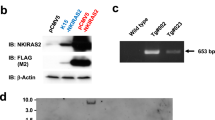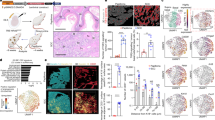Abstract
All-trans retinoic acid (RA), the principle biologically active form of vitamin A, is essential for many developmental process as well as homeostasis in the adult. Many lines of evidence also suggest that RA, acting through the RA receptors (RARs), can also suppress growth of tumors of diverse origin. To assess directly the role of the RARs in a model of epidermal tumorigenesis, we investigated the incidence of tumor formation using keratinocytes lacking specific RAR types. Our data suggest that loss of RARγ, but not RARα, predisposed keratinocytes to v-Ha-Ras-induced squamous cell carcinoma. We also found that ablation of RARγ, but not RARα, abolished RA-induced cell cycle arrest and apoptosis in these keratinocytes. Reconstitution of receptor expression into RAR-null cells restored sensitivity to RA, and reversed the tumorigenic potential of receptor-deficient keratinocytes. These data strongly support a tumor suppressor effect for the RARs, in particular endogenous RARγ, in murine keratinocytes.
This is a preview of subscription content, access via your institution
Access options
Subscribe to this journal
Receive 50 print issues and online access
$259.00 per year
only $5.18 per issue
Buy this article
- Purchase on Springer Link
- Instant access to full article PDF
Prices may be subject to local taxes which are calculated during checkout




Similar content being viewed by others
Abbreviations
- AP-1:
-
activating protein 1
- DMSO:
-
dimethyl sulfoxide
- ERK:
-
extracellular signal-regulated kinase
- JNK:
-
c-Jun amino-terminal kinase
- RA:
-
all-trans retinoic acid
- RAR:
-
retinoic acid receptor
- RARE:
-
retinoic acid-responsive element
- RXR:
-
retinoid X receptor
- SCC:
-
squamous cell carcinoma
- s.c.:
-
subcutaneous
- TPA:
-
12-O-tetradecanolphorbol-13-acetate
- TRE:
-
TPA-responsive element
References
Adnane J, Jackson RJ, Nicosia SV, Cantor AB, Pledger WJ and Sebti SM . (2000). Oncogene, 19, 5338–5347.
Altucci L and Gronemeyer H . (2001). Nat. Rev. Cancer, 1, 181–193.
Angel P and Karin M . (1992). Matrix. Suppl., 1, 156–164.
Berard J, Laboune F, Mukuna M, Masse S, Kothary R and Bradley WE . (1996). FASEB J., 10, 1091–1097.
Borriello A, Pietra VD, Criscuolo M, Oliva A, Tonini GP, Iolascon A, Zappia V and Ragione FD . (2000). Oncogene, 19, 51–60.
Bost F, Caron L, Marchetti I, Dani C, Marchand-Brustel Y and Binetruy B . (2002). Biochem. J., 361, 621–627.
Boudjelal M, Wang Z, Voorhees JJ and Fisher GJ . (2000). Cancer Res., 60, 2247–2252.
Boylan JF, Lufkin T, Achkar CC, Taneja R, Chambon P and Gudas LJ . (1995). Mol. Cell. Biol., 15, 843–851.
Boyle JO, Langenfeld J, Lonardo F, Sekula D, Reczek P, Rusch V, Dawson MI and Dmitrovsky E . (1999). J. Natl. Cancer Inst., 91, 373–379.
Chambon P . (1996). FASEB J., 10, 940–954.
Chapellier B, Mark M, Messaddeq N, Calleja C, Warot X, Brocard J, Gerard C, Li M, Metzger D, Ghyselinck NB and Chambon P . (2002). EMBO J., 21, 3402–3413.
Chen LC, Tarone R, Huynh M and De Luca LM . (1995). Cancer Lett., 95, 113–118.
Chiba H, Clifford J, Metzger D and Chambon P . (1997a). Mol. Cell. Biol., 17, 3013–3020.
Chiba H, Clifford J, Metzger D and Chambon P . (1997b). J. Cell. Biol., 139, 735–747.
Classon M and Harlow E . (2002). Nat. Rev. Cancer, 2, 910–917.
Darwiche N, Celli G, Tennenbaum T, Glick AB, Yuspa SH and De Luca LM . (1995). Cancer Res., 55, 2774–2782.
Darwiche N, Scita G, Jones C, Rutberg S, Greenwald E, Tennenbaum T, Collins SJ, De Luca LM and Yuspa SH . (1996). Cancer Res., 56, 4942–4949.
De Luca LM, Tarone R, Huynh M, Jones CS and Chen LC . (1996). Nutr. Cancer, 25, 249–257.
Dimberg A, Bahram F, Karlberg I, Larsson LG, Nilsson K and Oberg F . (2002). Blood, 99, 2199–2206.
Faria TN, Mendelsohn C, Chambon P and Gudas LJ . (1999). J. Biol. Chem., 274, 26783–26788.
Fisher GJ and Voorhees JJ . (1996). FASEB J., 10, 1002–1013.
Fontana JA and Rishi AK . (2002). Leukemia, 16, 463–472.
Ghyselinck NB, Dupe V, Dierich A, Messaddeq N, Garnier JM, Rochette-Egly C, Chambon P and Mark M . (1997). Int. J. Dev. Biol., 41, 425–447.
Gianni M, Kopf E, Bastien J, Oulad-Abdelghani M, Garattini E, Chambon P and Rochette-Egly C . (2002). J. Biol. Chem., 277, 24859–24862.
Gimenez-Conti I, Aldaz CM, Bianchi AB, Roop DR, Slaga TJ and Conti CJ . (1990). Carcinogenesis, 11, 1995–1999.
Goyette P, Feng CC, Wang W, Seguin F and Lohnes D . (2000). J. Biol. Chem., 275, 16497–16505.
Hanahan D and Weinberg RA . (2000). Cell, 100, 57–70.
Hansen LA, Brown D, Virador V, Tanaka T, Andreola F, Strain K, Dancheck B, Riley R, Arbeit JM, De Luca LM, Kogan S and Yuspa SH . (2003). Cancer Res., 63, 5257–5265.
Hengartner MO . (2000). Nature, 407, 770–776.
Houle B, Rochette-Egly C and Bradley WE . (1993). Proc. Natl. Acad. Sci. USA, 90, 985–989.
Houle M, Prinos P, Iulianella A, Bouchard N and Lohnes D . (2000). Mol. Cell. Biol., 20, 6579–6586.
Huang C, Ma WY, Dawson MI, Rincon M, Flavell RA and Dong Z . (1997). Proc. Natl. Acad. Sci. USA, 94, 5826–5830.
Jochum W, Passegue E and Wagner EF . (2001). Oncogene, 20, 2401–2412.
Karin M, Liu Z and Zandi E . (1997). Curr. Opin. Cell. Biol., 9, 240–246.
Kastner P, Mark M and Chambon P . (1995). Cell, 83, 859–869.
Katz ME and McCormick F . (1997). Curr. Opin. Genet. Dev., 7, 75–79.
Khosravi-Far R, White MA, Westwick JK, Solski PA, Chrzanowska-Wodnicka M, Van Aelst L, Wigler MH and Der CJ . (1996). Mol. Cell. Biol., 16, 3923–3933.
Kinzler KW and Vogelstein B . (1996). Cell, 87, 159–170.
Klaassen I, Brakenhoff RH, Smeets SJ, Snow GB and Braakhuis BJ . (2001). Int. J. Cancer, 92, 661–665.
Kueng W, Silber E and Eppenberger U . (1989). Anal. Biochem., 182, 16–19.
Kumar R, Shoemaker AR and Verma AK . (1994). Carcinogenesis, 15, 701–705.
Langenfeld J, Kiyokawa H, Sekula D, Boyle J and Dmitrovsky E . (1997). Proc. Natl. Acad. Sci. USA, 94, 12070–12074.
Larcher F, Bauluz C, Diaz-Guerra M, Quintanilla M, Conti CJ, Ballestin C and Jorcano JL . (1992). Mol. Carcinogen, 6, 112–121.
Le Q, Dawson MI, Soprano DR and Soprano KJ . (2000). Oncogene, 19, 1457–1465.
Lee HY, Sueoka N, Hong WK, Mangelsdorf DJ, Claret FX and Kurie JM . (1999). Mol. Cell. Biol., 19, 1973–1980.
Liu M, Iavarone A and Freedman LP . (1996). J. Biol. Chem., 271, 31723–31728.
Lohnes D, Kastner P, Dierich A, Mark M, LeMeur M and Chambon P . (1993). Cell, 73, 643–658.
Lohnes D, Mark M, Mendelsohn C, Dolle P, Dierich A, Gorry P, Gansmuller A and Chambon P . (1994). Development, 120, 2723–2748.
Lufkin T, Lohnes D, Mark M, Dierich A, Gorry P, Gaub MP, LeMeur M and Chambon P . (1993). Proc. Natl. Acad. Sci. USA, 90, 7225–7229.
Marks R . (1995). Cancer, 75, 607–612.
Mehta K . (2003). J. Biol. Regul. Homeost. Agents, 17, 1–12.
Mendelsohn C, Lohnes D, Decimo D, Lufkin T, LeMeur M, Chambon P and Mark M . (1994). Development, 120, 2749–2771.
Mittnacht S . (1998). Curr. Opin. Genet. Dev., 8, 21–27.
Moller MB . (2000). Leukemia Lymphoma, 39, 19–27.
Naderi S and Blomhoff HK . (1999). Blood, 94, 1348–1358.
Nelson KG and Slaga TJ . (1982). Cancer Res., 42, 4176–4181.
Nevins JR . (2001). Hum. Mol. Genet., 10, 699–703.
Oridate N, Esumi N, Lotan D, Hing WK, Rochette-Egly C, Chambon P and Lotan R . (1996). Oncogene, 12, 2019–2028.
Pepper C, Ali K, Thomas A, Hoy T, Fegan C, Chowdary P, Kell J and Bentley P . (2002). Eur. J. Haematol., 69, 227–235.
Philipp J, Vo K, Gurley KE, Seidel K and Kemp CJ . (1999). Oncogene, 18, 4689–4698.
Robles AI, Rodriguez-Puebla ML, Glick AB, Trempus C, Hansen L, Sicinski P, Tennant RW, Weinberg RA, Yuspa SH and Conti CJ . (1998). Genes Dev., 12, 2469–2474.
Rommel C and Hafen E . (1998). Curr. Opin. Genet. Dev., 8, 412–418.
Roop DR, Lowy DR, Tambourin PE, Strickland J, Harper JR, Balaschak M, Spangler EF and Yuspa SH . (1986). Nature, 323, 822–824.
Ross SA, McCaffery PJ, Drager UC and De Luca LM . (2000). Physiol. Rev., 80, 1021–1054.
Sebolt-Leopold JS . (2000). Oncogene, 19, 6594–6599.
Shaulian E and Karin M . (2002). Nat. Cell Biol., 4, E131–E136.
Sheikh MS, Shao ZM, Li XS, Dawson M, Jetten AM, Wu S, Conley BA, Garcia M, Rochefort H and Fontana JA . (1994). J. Biol. Chem., 269, 21440–21447.
Stevaux O and Dyson NJ . (2002). Curr. Opin. Cell Biol., 14, 684–691.
Sun SY and Lotan R . (2002). Crit. Rev. Oncol. Hematol., 41, 41–55.
Taneja R, Bouillet P, Boylan JF, Gaub MP, Roy B, Gudas LJ and Chambon P . (1995). Proc. Natl. Acad. Sci. USA, 92, 7854–7858.
Taneja R, Roy B, Plassat JL, Zusi CF, Ostrowski J, Reczek PR and Chambon P . (1996). Proc. Natl. Acad. Sci. USA, 93, 6197–6202.
Topley GI, Okuyama R, Gonzales JG, Conti C and Dotto GP . (1999). Proc. Natl Acad. Sci. USA, 96, 9089–9094.
Wang Z, Boudjelal M, Kang S, Voorhees JJ and Fisher GJ . (1999). Nat. Med., 5, 418–422.
Webb CP, Van Aelst L, Wigler MH and Woude GF . (1998). Proc. Natl. Acad. Sci. USA, 95, 8773–8778.
Wei LN . (2003). Annu. Rev. Pharmacol. Toxicol., 43, 47–72.
Weinberg RA . (1995). Cell, 81, 323–330.
Weinstein IB . (2002). Science, 297, 63–64.
White MA, Nicolette C, Minden A, Polverino A, Van Aelst L, Karin M and Wigler MH . (1995). Cell, 80, 533–541.
Wu JM, DiPietrantonio AM and Hsieh TC . (2001). Apoptosis, 6, 377–388.
Xu L, Glass CK and Rosenfeld MG . (1999). Curr. Opin. Genet. Dev., 9, 140–147.
Xu XC, Wong WY, Goldberg L, Baer SC, Wolf JE, Ramsdell WM, Alberts DS, Lippman SM and Lotan R . (2001). Cancer Res., 61, 4306–4310.
Yen A, Roberson MS and Varvayanis S . (1999). In vitro Cell Dev. Biol. Anim., 35, 527–532.
Young MR, Li JJ, Rincon M, Flavell RA, Sathyanarayana BK, Hunziker R and Colburn N . (1999). Proc. Natl. Acad. Sci. USA, 96, 9827–9832.
Yuspa SH, Dlugosz AA, Denning MF and Glick AB . (1996). J. Invest. Dermatol. Symp. Proc., 1, 147–150.
Zhang LX, Mills KJ, Dawson MI, Collins SJ and Jetten AM . (1995). J. Biol. Chem., 270, 6022–6029.
Zhang D, Vuocolo S, Masciullo V, Sava T, Giordano A, Soprano DR and Soprano KJ . (2001). Oncogene, 20, 7935–7944.
Acknowledgements
We would like to thank H Liénard and C Charbonneau for assistance with photography, SH Yuspa for the v-Ha-ras retrovirus, and members of the laboratory for suggestions. This work was supported by the National Cancer Institute of Canada with funds from the Canadian Cancer Society. CFC was supported by a scholarship from the Cancer Research Society, Inc., and PG by a fellowship from the Canadian Institutes for Health Research. DL is a chercheur bourcier (Senior) of the Fonds de la Recherches en Santé de Québec.
Author information
Authors and Affiliations
Corresponding author
Rights and permissions
About this article
Cite this article
Chen, C., Goyette, P. & Lohnes, D. RARγ acts as a tumor suppressor in mouse keratinocytes. Oncogene 23, 5350–5359 (2004). https://doi.org/10.1038/sj.onc.1207682
Received:
Revised:
Accepted:
Published:
Issue Date:
DOI: https://doi.org/10.1038/sj.onc.1207682
Keywords
This article is cited by
-
The miR-96 and RARγ signaling axis governs androgen signaling and prostate cancer progression
Oncogene (2019)
-
Retinoids as an Immunity-modulator in Dermatology Disorders
Archivum Immunologiae et Therapiae Experimentalis (2019)
-
RARγ-induced E-cadherin downregulation promotes hepatocellular carcinoma invasion and metastasis
Journal of Experimental & Clinical Cancer Research (2016)
-
Crossing the Barrier: STRA6 in Epidermal Differentiation
Journal of Investigative Dermatology (2014)



